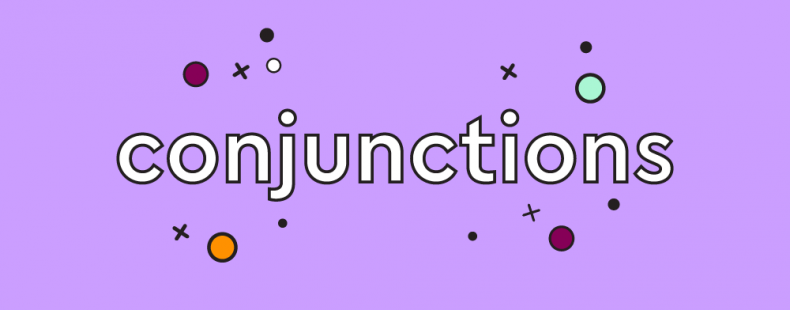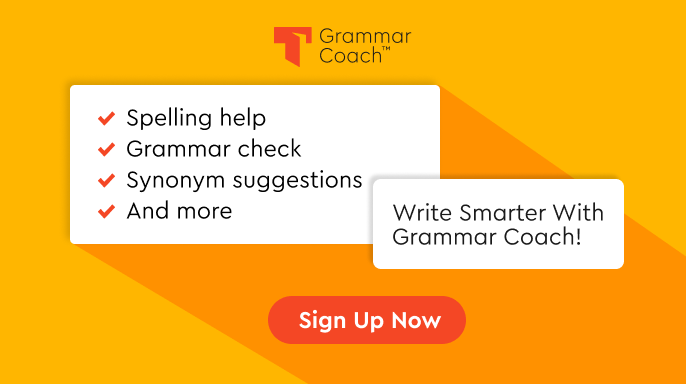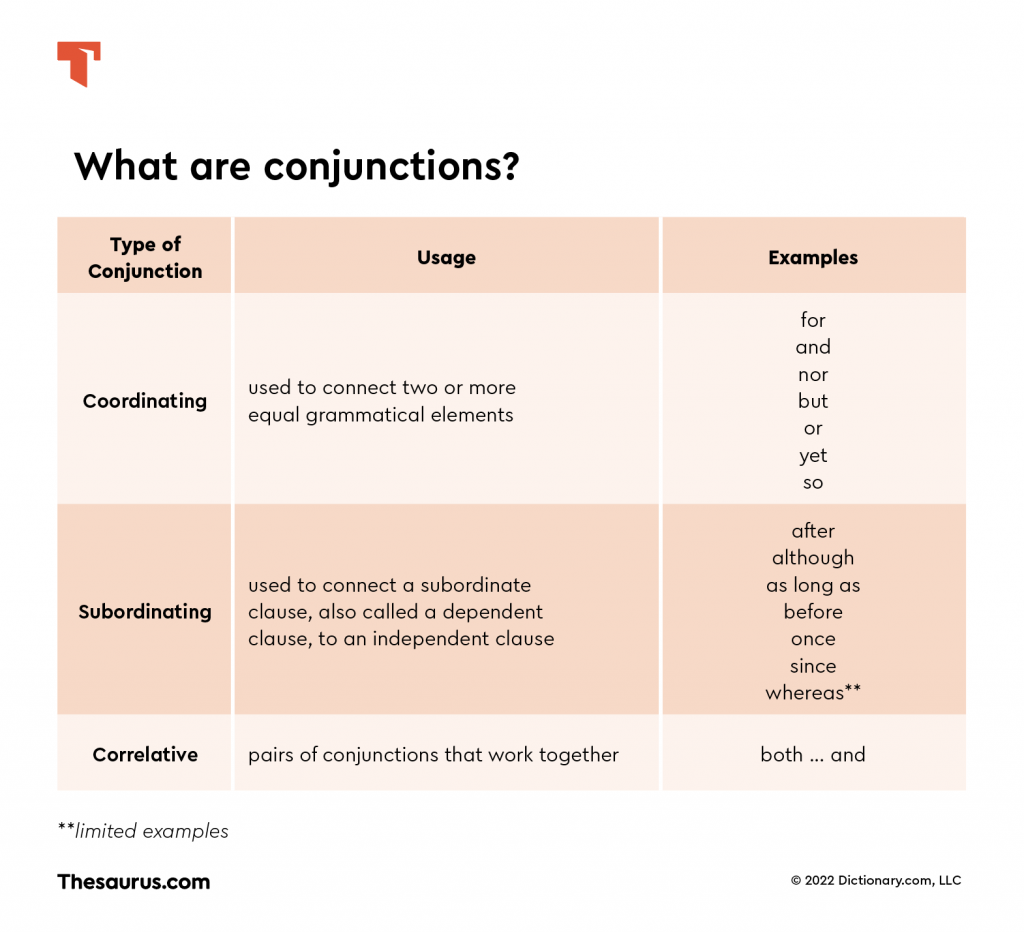The children were asleep. Their parents were asleep. Their dogs were asleep. These sentences work fine separately but seem a little repetitive, don’t you think? Instead, let’s use a conjunction to connect them together. The children, their parents, and their dogs were asleep. That looks a lot better, right? Conjunctions are very useful words that connect parts of speech together to form more complex sentences. Let’s learn more about these grammatical matchmakers and how we can use them to write better sentences we’ll love.
What is a conjunction?
A conjunction is a word or phrase that connects words, phrases, clauses, and sentences together. The word and is a commonly used example of a conjunction. Here are two examples of how we can use a conjunction like and in both a simple and complex way:
- The flower is yellow and white. (connects two adjectives)
- The flower is yellow, and it has a particular smell. (connects two sentences)
Conjunctions are useful in writing and speech to connect related ideas together, and they help us make our sentences shorter, less repetitive, or less confusing.
Conjunction examples
Some of the most commonly used words are conjunctions. Let’s take a look at some examples and how we would use them in sentences.
List of common conjunctions
The following list contains some of the most commonly used conjunctions:
- and
- but
- or
- so
- because
- however
- after
- since
- during
- than
- unless
- that
- while
⚡️Conjunctions in a sentence
Here are some example sentences that show the different ways we can use conjunctions:
- The parking lot was filled with cars, trucks, and buses.
- Natalie thinks cats are cute, but she can’t have any because she is allergic to them.
- Before we can travel to Europe, we have to get passports.
- He showed me the jacket that he bought yesterday.
- The talented acrobats impressed both the children and their parents.
Types of conjunctions
Coordinating conjunctions
A coordinating conjunction is a conjunction that connects two or more equal grammatical elements. In practice, this usually means a coordinating conjunction will connect the same parts of speech, such as a verb to another verb. For example:
- Everyone sang and danced.
Importantly, coordinating conjunctions are the conjunctions used to connect independent clauses together. An independent clause is a phrase that can stand alone as a complete sentence. Take a look at the following two clauses:
- He might have gone to the park.
- He may have returned home.
These are both complete sentences. We can use a coordinating conjunction to join them into one sentence. If we do, the coordinating conjunction will follow a comma:
- He might have gone to the park, or he may have returned home. (Or connects two sentences.)
Subordinating conjunctions
A subordinating conjunction is used to connect a subordinate clause, also called a dependent clause, to an independent clause. Unlike an independent clause, a subordinate clause cannot stand by itself as a complete sentence. For example:
- where the buffalo roam (not a complete sentence)
However, we can use a subordinating conjunction to attach a subordinate clause to an independent clause. Subordinating conjunctions can either come at the beginning of a sentence or somewhere in the middle:
- Whenever it rains, we stay inside and watch movies.
- We stay inside and watch movies whenever it rains.
Correlative conjunctions
Correlative conjunctions are pairs of conjunctions that work together. Some examples of correlative conjunctions include both … and, either … or, neither … nor, and rather … than. Each pair of correlative conjunctions has a different function. Here are a few examples:
- I need flowers that are either red or pink. (lists two options)
- She would much rather play outside than sit in the house. (states a preferred choice)
- The dog was as big as a horse! (forms a simile)
How much do you know about prepositions? Learn about them here.
Conjunction rules
For the most part, conjunctions aren’t too tough to use correctly. However, there are some rules to keep in mind.
Where to place conjunctions
In general, conjunctions are frequently used between the things they connect. For example,
- I am hungry and tired.
- He tried to buy some food, but the store was closed.
- Cheetahs run faster than most other animals.
Two exceptions to this general rule are subordinating conjunctions, which can be used at the beginning of sentences, and the first of a pair of correlative conjunctions:
- Since we were kids, we have loved riding roller coasters.
- The soup has both carrots and onions.
It is often said that you can’t begin a sentence with coordinating conjunctions like and or but. However, this “rule” is often broken, and it is perfectly acceptable to begin a sentence with a coordinating conjunction. You just need to make sure your sentences are clear. For example:
- You might think we know everything there is to know about dinosaurs. But you’d be wrong.
- The Grinch never liked Christmas trees. Or anything else that had to do with Christmas.
Proper comma usage
The comma is oftentimes the punctuation mark that causes people the most problems. In general, these are the rules of using commas with conjunctions:
1. Coordinating conjunctions: Use a comma before the conjunction when connecting independent clauses together or when creating a list. Don’t use a comma if connecting things that aren’t independent clauses:
- Independent clause: I love my sister, and she loves me. (comma)
- List: I’ll eat vanilla, chocolate, or strawberry ice cream. (comma)
- Not an independent clause: This sweater is hot and itchy. (no comma)
2. Subordinating conjunctions: You don’t need a comma unless a subordinating clause is used at the beginning of a sentence. If it is, put a comma at the end of the entire subordinate clause:
- No comma: I passed the test easily because I studied really hard.
- Comma: Because I studied really hard, I passed the test easily.
3. Correlative conjunctions: Typically, correlative conjunctions don’t need a comma. It is possible that they may appear near a comma, though, if a comma is being used for another reason, such as separating out a modifier. For example,
- I spoke to both Abby, who didn’t know what happened, and Will, who did.
Using different types of conjunctions together
It is perfectly fine to use all of the different types of conjunctions together in the same sentence. Just remember that coordinating conjunctions are used to join independent clauses and subordinating conjunctions are used to join subordinate clauses to independent clauses. Sometimes, sentences can get very long and complicated, but you still need to remember when and where to use commas.
Here is an example of a complicated sentence that uses all three types of conjunctions. Take note that only the coordinating conjunction that connects two independent clauses uses a comma:
- I tried to convince my mom and dad I was innocent, but my plan failed because both my younger brother and my younger sister told them that I broke the window.
Quiz yourself on how well you know conjunctions now!
Grammar Coach™: both helpful and essential
Improve your writing with Thesaurus.com’s Grammar Coach™, an online writing tool that catches grammar and spelling errors and provides Thesaurus-powered synonym suggestions. Using machine learning, Grammar Coach™ can spot the difference between the different types of conjunctions, their correct and incorrect uses—and much more! Perfect grammar has never been easier.
















